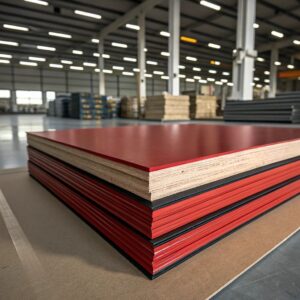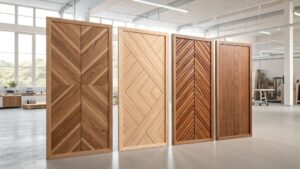
When it comes to furniture plywood, the number of plies is more than just a number – it directly affects the strength, durability, and appearance of your final product. As a B2B plywood supplier in China, we at ACEALL often receive questions like: "How many plies should I choose for cabinet panels?" or "Does more plies mean better quality?"
In this article, we explain everything you need to know about ply count from an importer’s perspective. Whether you’re sourcing from China, New Zealand, or elsewhere, this guide will help you make better purchasing decisions and avoid common quality issues.
1.What Does "Number of Plies" in Plywood Mean?

Each plywood board is made by gluing together thin layers of wood veneer1, known as plies. The number of plies2 refers to how many layers are used in the construction of the board.
- 3-ply3: Typically thinner and more flexible
- 5-ply or 7-ply: Standard for furniture-grade plywood
- 9+ ply: For high-strength applications like flooring or structural use
🟢 More plies usually mean higher strength and stability – but only if the glue and veneer quality are up to standard.
2.Why the Number of Plies Matters for Furniture Importers

1. Strength and Stability
More plies make the board stronger and less likely to warp or bend. For furniture manufacturers, this is critical for pieces like:
- Cabinet doors
- Tabletops
- Wardrobe panels
2. Surface Smoothness
More plies = better core balance, resulting in a smoother surface for lamination (like melamine or veneer). This improves final aesthetics.
3. Resistance to Cracking
Boards with fewer plies may split or crack more easily, especially under pressure or in dry climates.
3.Common Ply Counts in Furniture Plywood
| Ply Count | Typical Thickness | Common Use Case |
|---|---|---|
| 3-ply | 3mm – 5mm | Drawer bottoms, low-load panels |
| 5-ply | 9mm – 12mm | Standard cabinets, wardrobes |
| 7-ply | 12mm – 15mm | Tabletops, shelves |
| 9+ ply | 18mm – 25mm | High-end furniture, heavy structures |
❗ Reminder: Ply count is important, but veneer type, glue quality, and pressing technique are equally critical.
4.Mistakes Importers Make When Ignoring Ply Count
- Buying low-ply boards for high-load furniture → leads to complaints or returns
- Not asking for ply specifications in quotations → resulting in unexpected quality issues
- Believing “more plies = always better” → wasting cost on unnecessary strength
5.How ACEALL Ensures Ply Count Matches Export Quality

As a factory with 8 production lines, we understand that ply consistency and lamination are key to stable furniture production. Here’s how we ensure it:
- ✔️ Strict core veneer inspection (moisture content, thickness uniformity)
- ✔️ Ply count documented in each production batch
- ✔️ Support for customized ply structures (e.g. 3-ply, 5-ply, 9-ply)
- ✔️ High-pressure melamine lamination with even surface density
🔍 Want a sample report? Contact sales@aceallwood.com
6.How to Choose the Right Ply Count for Your Needs

🪑 For furniture factories:
Use 5–7 ply boards for general furniture, and 9+ ply for load-bearing parts.
🌍 For export buyers:
- Choose higher plies in dry/cold climates (Canada, Northern Europe)
- Ask suppliers for technical data sheets that confirm ply and glue standards
💡 Our Tip:
If your local processing involves CNC cutting or UV coating, choose plywood with more layers and smoother balance.
7.Conclusion: Choose the Right Ply Count, Not the Highest
The right number of plies depends on your application, climate, and customer expectations. More is not always better – but matching the correct ply structure with your product needs can save money and prevent quality problems.
At ACEALL, we export melamine plywood panels globally with consistent ply counts, smooth finishes, and customizable specifications. If you're sourcing from China and care about quality, price, and service, let’s connect.
📩 Contact Zoe at sales@aceallwood.com
🌐 Learn more: www.aceallwood.com
8.FAQ: Number of Plies in Plywood
Q1: Is more plies in plywood always better?
A: Not necessarily. More plies can mean more strength, but only if glue and veneer quality are also high.
Q2: What is the standard number of plies in furniture plywood?
A: Typically 5 to 9 plies depending on thickness and use.
Q3: Can I request custom ply structure from Chinese suppliers?
A: Yes, factories like ACEALL support customized ply count, core type, and thickness.
-
Understanding the role of wood veneer layers can enhance your knowledge of plywood quality and applications. ↩
-
Exploring this topic will help you make informed decisions when selecting plywood for various projects. ↩
-
Learning about 3-ply plywood can guide you in choosing the right material for flexible and lightweight applications. ↩



